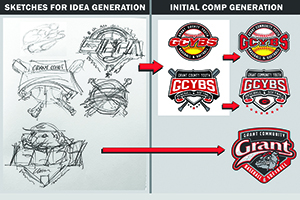June 10, 2013
I frequently get calls from customers asking for advice on how to print on polyester. Although this topic has been covered in previous articles, here are some quick tips:
1. One of the main problems with printing on polyester is that the dye in the fabric can bleed into your printed design, caused by dye migration. Do a test print on a sample of your fabric to see if it will bleed. Ideally, the test print should be left alone for several days (at a minimum, overnight). Keeping it at an elevated temperature can speed things along as well. Dye migration does not always happen right away, so what may look like a white print on a red shirt an hour after printing may turn into a pink print the next day.
2. High heat is detrimental for polyester, as it can act as a catalyst for dye migration while also causing the actual fabric to pucker or melt. Add a low-cure additive (such as International Coatings’ 3804 Low Cure Additive) or print with inks specifically formulated for polyester (such as International Coatings’ 7100 Performance Pro, with 19 colors available), which cure at lower temperatures.
Please remember that as you are keeping the temperature as low as possible to combat the dye migration issues, the ink must still achieve its needed cure temperature — whether it is a low-cure or regular type. So make sure the entire ink film hits the required minimum curing temperature as prescribed by the ink manufacturer.
3. If you are printing multiple colors and need to use a flash in between printing each, I suggest preflashing the fabric. The polyester may shrink slightly during the flash process, and preflashing may prevent shifts in your registration during subsequent printing.
4. When printing multiple colors on polyester, don’t forget that if you use an underbase and a poly white that cures at a lower temperature, you also should use colors that cure at a lower temperature. I’ve received several calls from printers who used a low-cure white for the underbase, then use regular plastisol for subsequent colors without adding a low-cure additive. The result is that the colors either did not cure properly due to the lower curing temperatures, thus coming off during the wash, or the polyester fabric melted and shrank because they used a higher temperature to make ensure the colors withstood washing. In addition, the higher temperature can accelerate dye migration.
5. Conduct a wash test before starting full production. This will determine if your ink cured properly and whether problems lie ahead.
Kieth Stevens is the Western regional sales manager for International Coatings. He has been teaching screen printing for more than 10 years and is a regular contributor to International Coatings’ blogs. For more ink tips and information, visit iccink.com and read the company’s blog at
internationalcoatingsblog.com.
April 5, 2024 | Process + Techniques
Why do we often struggle with some of the seemingly simplest things, like slathering screen-printing ink onto a decorated-apparel garment. Slathering so that it looks clean, bright, opaque and altogether attractive.
FULL STORY
March 13, 2024 | Process + Techniques
Wouldn’t it be wonderful if there was a secret formula for designing a best-selling T-shirt for a sports team, a business or for your own pre-print line?
FULL STORY
January 25, 2024 | Process + Techniques
As is the case with any craft, when it comes to screen-printing T-shirts and other apparel the devil is in the details. The best art, the best press in the world will inevitably come up short if you don’t take care of the little things as well.
FULL STORY




